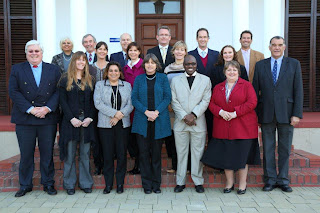Food shortages were one of the smaller effects that the Great Depression had on school life. The girls were given smaller meals, consisting of very little meat and mostly small portions of bread and soup. To many of the girls' disappointment, no ''tuck'' was allowed in school due to the tough economic situation in Cape Town during that decade.
 |
| Miss Ralph |
Despite the limitations brought about by the Great Depression, the school did expand greatly under Miss Robinson's leadership and focus on developing Herschel's facilities and grounds; most of Herschel's funds were directed to this aspect when Miss Robinson was Headmistress. These new facilities and additions to the grounds attracted more girls to join the Herschel community, and the number of girls in the school increased from its initial number of 52 in 1933 to 215 girls by the end of the 1930s.
There was great modernisation and a large increase in size of Cape Town during the 1930s. This can be attributed to the Great Depression. This economic decline was felt largely in the agricultural sector of our economy. This resulted in urbanisation, as large sums of agricultural workers came to cities in hope of finding alternative work, as the agricultural sector was no longer a stable source of income. There was great residential growth in Claremont in particular, which was relevant to Herschel as with more people living in Claremont, there would be more families who would possibly enroll their daughters in the school.
 |
| Tram photographed in Cape Town in the 1930s. |
Claremont also expanded in facilities and recreational sites. St Ignatius Church was built in 1932, a post office was built in 1936 and many cinemas and malls were also established. This resulted in Claremont becoming a more attractive living area, and with that more people came to live in Claremont, with some bringing daughters with them who they would possibly send to Herschel.
This expansion in Claremont in the 1930s caused the numbers of girls attending Herschel to increase largely. Claremont became more modern, easily accessible and increased in appeal due to expansion of recreational areas. This expansion of the school resulted in Herschel becoming more credible and noted, which increased attendance in the years to come.
Author: Tessa Chittenden
References:
AUTHOR UNKNOWN. 1972. The Stars looked down: Herschel School 1922-1972. Cape Town. Margaret Saffery.
Great Depression. 2012. [Online]. Available: http://en.wikipedia.org/wiki/Great_Depression. [viewed 19th September 2012]
HART, P. 1999. Claremont, Newlands and Bishopscourt street names. Cape Town. Martingraphix.
MURRAY, J. 1958. Claremont Album. Cape Town. A.A Baklema Publishers.
WORDEN, N; HEYNINGEN, E; BICKFORD-SMITH, V. 1998. Cape Town: The making of a city. Cape Town: David Philip Publishers.




